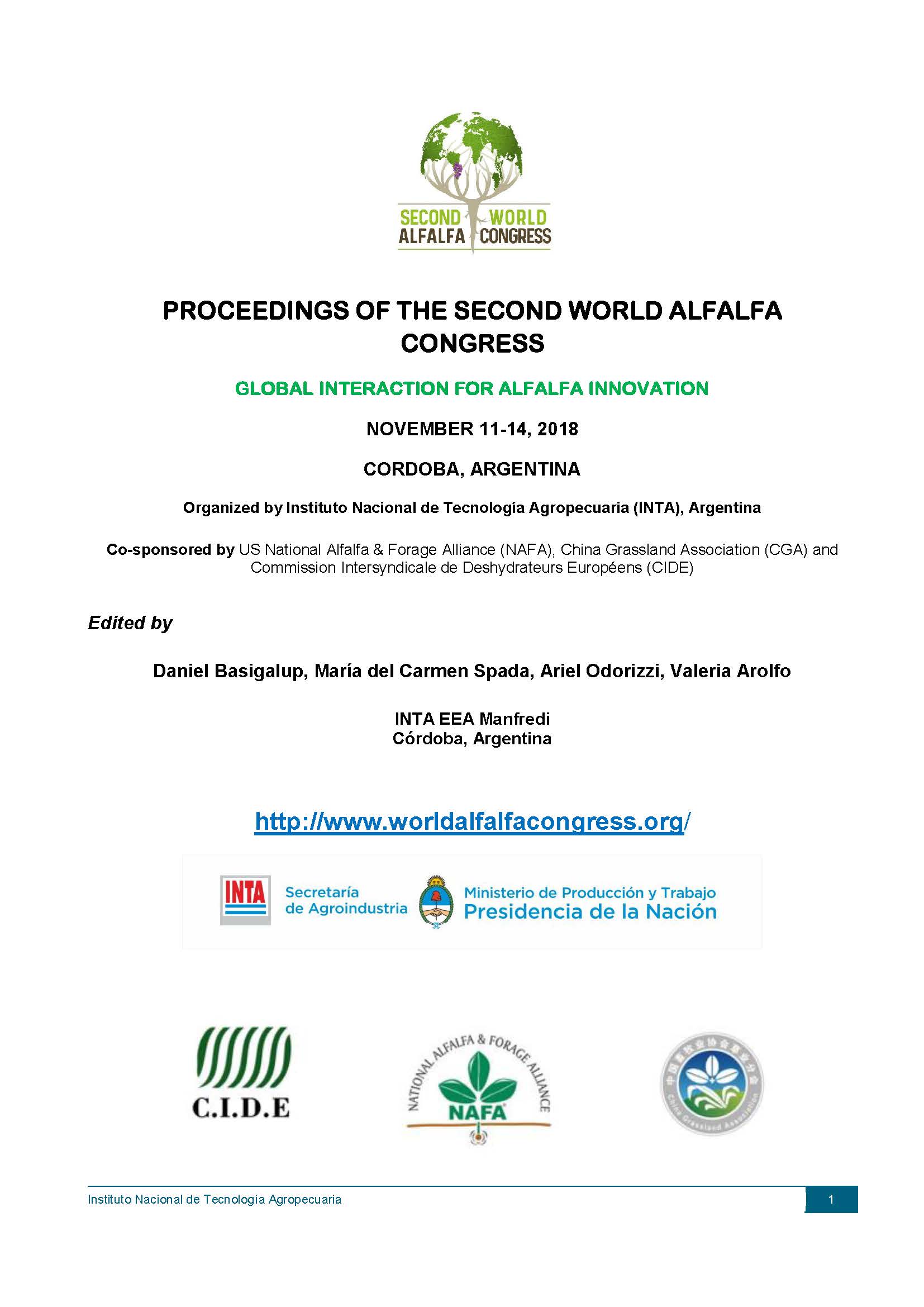View Item
- xmlui.general.dspace_homeCentros Regionales y EEAsCentro Regional CórdobaEEA ManfrediPresentaciones a congresosxmlui.ArtifactBrowser.ItemViewer.trail
- DSpace Home
- Centros Regionales y EEAs
- Centro Regional Córdoba
- EEA Manfredi
- Presentaciones a congresos
- View Item
An overview of alfalfa (Medicago sativa L.) situation in Argentina
Abstract
From the approximately 3.2 million ha of alfalfa grown in Argentina in 2018, about 60% is planted as pure stands and 40% in mixtures with temperate forage grasses. Pure stands are primarily used for dairy and hay production, while mixtures with grasses are usually devoted to beef production. More than 426 varieties have been registered between 1980 and March 2018, and about 120 varieties are currently in the market. Among these varieties, 65% belong to
[ver mas...]
From the approximately 3.2 million ha of alfalfa grown in Argentina in 2018, about 60% is planted as pure stands and 40% in mixtures with temperate forage grasses. Pure stands are primarily used for dairy and hay production, while mixtures with grasses are usually devoted to beef production. More than 426 varieties have been registered between 1980 and March 2018, and about 120 varieties are currently in the market. Among these varieties, 65% belong to fall dormancy (FD) rates 8-10 and 35% to FD 6-7. The majority of those cultivars come from private companies, either domestic or international. Most of the new releases are provided by USA and, to a lesser extent, Australian breeding programs; however, INTA’s varieties currently have about 15% market share. The National Alfalfa Cultivar Evaluation Network is being conducted by INTA Manfredi since 1992 in an attempt to help farmers in the process of choosing the most adapted varieties. This network has 17 locations across the country which represents the wide range of environmental conditions and production systems (rain fed or irrigated). Forage yield (t DM ha-1 year-1) and stand density (persistence) are statistically analyzed and published annually (Arolfo and Odorizzi, 2017). Results from the last 10 years show that average forage production for FD 5-7 cultivars ranges from 5 t (metric tons) DM ha-1 year-1 in Anguil (Semiarid Pampa Region-5 cuts) to 24 t DM ha-1 year-1 in Marcos Juárez (Sub-humid Pampa Region-6 cuts) under rain fed conditions; and 17.2 t DM ha-1 year-1 in Hilario Ascasubi (Southern Pampa Region-6 cuts) to 20 t DM ha-1 year-1 in Viedma (Northern Patagonia-6 cuts) under irrigation. For the non-dormant cultivars (FD 8-10), forage production ranges from 5.3 t DM ha-1 year-1 in Anguil (5 cuts) to 25.2 t DM ha-1 year-1 in Marcos Juárez (8 cuts) under rain fed conditions; and 17.3 t DM ha-1 year-1 in Catamarca (Northwestern Region-8 cuts) to 23 t DM ha-1 year-1 in Santiago del Estero (North-Western Region-8 cuts) under irrigation. In bovine production, rotational grazing is still very important in Argentina. Compared to other production systems, grazing alfalfa offers lower production costs and better utilization of alfalfa forage quality; on the other hand, it increases the risk of bloat and requires longer cattle finishing periods. Nonetheless, the use of feed-lot type operations has dramatically increased in the last 15 years. Utilization of corn or sorghum silage and alfalfa hay has become increasingly important for most dairy and beef production systems that use varied degrees of cattle confinement. Despite this, nearly 55% of milk is still produced in grazing-based systems in which alfalfa represents 50% (winter) to 80% (spring and summer) of the total diet.
[Cerrar]

Fuente
Proceedings of the Second World Alfalfa Congress Global Interaction for Alfalfa Innovation. Cordoba, Agentina, 11-14 noviembre, 2018, p. 25-29
Date
2018-11-11
Editorial
INTA
Documentos Relacionados
Formato
pdf
Tipo de documento
documento de conferencia
Proyectos
(ver más)
INTA/PNBIO/1131024/AR./Desarrollo de sistemas alternativos de generación y utilización de variabilidad genética y su aplicación al mejoramiento de los cultivos.
INTA/CORDO/1262205/AR./Proyecto regional del territorio agrícola ganadero central de la provincia de Córdoba.
INTA/PNPA/1126072/AR./Desarrollo de cultivares superiores de especies forrajeras para sistemas ganaderos y agricolo-ganaderos de la Argentina.
INTA/CORDO/1262204/AR./Gestión de la innovación en el territorio del arco noroeste de la provincia de Córdoba.
INTA/CORDO/1262206/AR./PReT - Zona III centro Este - Centro Regional Córdoba.
Palabras Claves
Derechos de acceso
Abierto
 Excepto donde se diga explicitamente, este item se publica bajo la siguiente descripción: Creative Commons Attribution-NonCommercial-ShareAlike 2.5 Unported (CC BY-NC-SA 2.5)
Excepto donde se diga explicitamente, este item se publica bajo la siguiente descripción: Creative Commons Attribution-NonCommercial-ShareAlike 2.5 Unported (CC BY-NC-SA 2.5)


